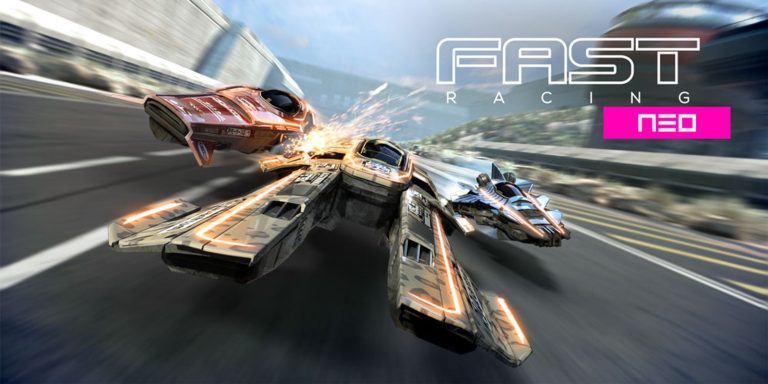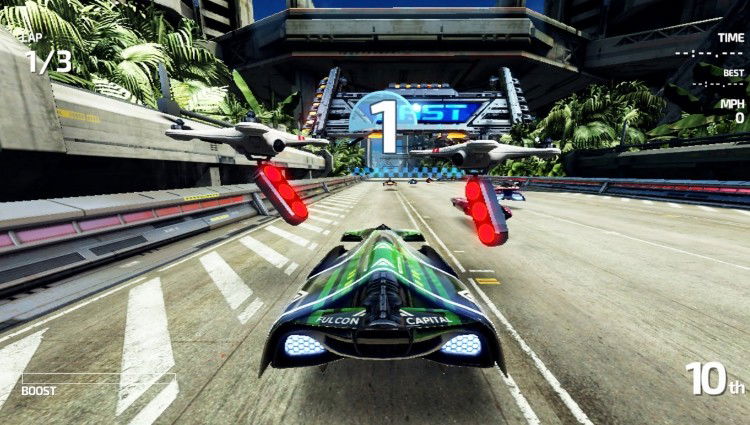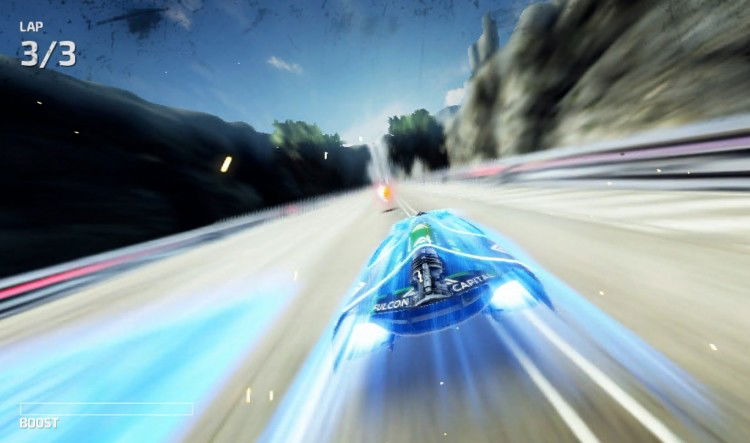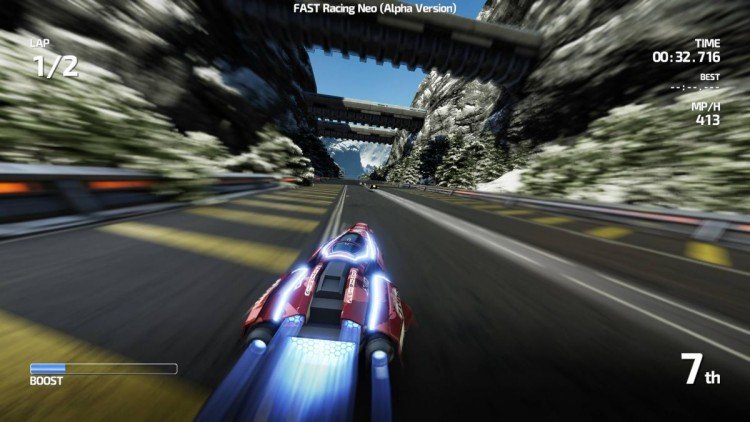Way back in the Super Nintendo era, Nintendo introduced a racing game that many still consider one of the genre’s all-time greats. It was a standout title—fast, futuristic, and ahead of its time. That game was F-Zero. Not only did it spawn several sequels, but it also inspired a wave of high-speed racers like Wipeout and Extreme-G. Despite its legacy, we haven’t seen a proper follow-up to the series since F-Zero GX on the GameCube. For fans of lightning-fast racing and futuristic tracks, the absence has been felt for years. Can Shin’en Multimedia fill that void with its futuristic racing title, Fast Racing Neo? We’re about to find out.
Game Name: Fast Racing NEO
Platform(s): Wii U
Genre: Racing
Publisher(s): Shin’en Multimedia
Developer(s): Shin’en Multimedia
Release Date: December 10, 2015
Price: $14.99
Thankfully, we have studios like Shin’en Multimedia stepping in to fill the void. With Fast RMX, they’ve crafted a wickedly fast racing experience that captures the spirit of F-Zero while carving out its own identity. It’s easy to draw comparisons to Fast Racing Neo—and those are absolutely warranted—but if I’m being honest, Fast RMX actually reminds me more of Wipeout. From the handling to the track layouts, there’s a similar sense of flow and futuristic design that leans more in that direction.
You can play Fast RMX using either the Wii U GamePad or the Pro Controller, but after testing both, I definitely give the edge to the Pro Controller. Thankfully, once the game starts, you’re not forced to use the GamePad for anything specific, which is a relief.
That said, the control scheme is a bit more complex than you’d expect for a racing game. You’ve got several essential inputs: accelerate, brake, left/right lean (which helps with tight turns and mid-air adjustments), and the all-important Phase Switch. This last mechanic is absolutely crucial if you want to stay competitive, so let’s break it down.
During races, you’ll see glowing strips on the track—either blue or orange. These are phase pads, and they’re everywhere. To take advantage of them, you need to switch your vehicle’s phase to match the color of the pad. Get it right, and you’ll get a speed boost. Get it wrong, and you’ll grind to a halt. Mastering phase switching is key to shaving seconds off your time and staying ahead of the pack.
At first, it might seem like you should just drive straight into those glowing strips on the track—but that’s not how it works. To activate them, your ship needs to match the strip’s color. That’s where the Phase Switch mechanic comes into play. Tapping the button switches your ship’s phase between orange and blue. Hit a strip while in the correct phase, and you’ll be rewarded with a speed boost. Mistime it, and you’ll slow down drastically the longer you stay in the strip. It’s a deceptively simple system that adds a lot of depth to each race.
In addition to phase strips, boost orbs are scattered around the track. Collecting them fills your boost meter, which appears in the bottom-left corner of the screen. Once you’ve charged it up, you can hit the boost to rocket forward—useful for improving lap times or delivering a well-timed slam into another racer, potentially knocking them off-course. It’s a great risk-reward mechanic that gives races a chaotic, tactical edge.
The tracks themselves are where Fast RMX really shines. This isn’t just a game about racing—it’s also about surviving the tracks. Each course features environmental hazards that can seriously mess with your run. Fire pits erupt mid-race, waterfalls obscure your view, and some track segments are suspended by cranes that sway dangerously. One course even features a massive four-legged mecha stomping across the track, slamming its legs down—sometimes directly in your path.
While these elements add excitement, they can also be frustrating. Some gimmicks feel more punishing than fun, and in a few cases, they risk discouraging players instead of pushing them to improve. Still, there’s a ton of variety in the track design, and graphically, some of these environments are among the best visuals I’ve seen on the Wii U—outside of Nintendo’s own first-party titles. Major props to Shin’en Multimedia for that.
And don’t worry about the AI being pushovers. Even in the beginner Subsonic league, they’re aggressive and relentless. They’ll overtake you in a flash if you slip up, slam into your vehicle without hesitation, and even knock you out of the air mid-jump. I’ve had more than a few races end with me yelling at the screen as an AI opponent sent me flying off the course. They’re ruthless—and I kind of love it.
Graphically, Fast Racing NEO is a stunner in motion. The track detail and vehicle models are impressive, and the game runs at a rock-solid 60 frames per second without missing a beat. When you hit a boost pad or trigger your own boost, your vision blurs in a way that feels ripped straight from a sci-fi movie—like a starship jumping to hyperspace. It’s colorful, vivid, and exhilarating.
But stand still, and the cracks begin to show. Jaggies and blurred textures are noticeable, a clear trade-off made to maintain that buttery frame rate. It’s a compromise we’ve seen in many Wii U titles, and while it doesn’t detract much from the experience, visual purists might take issue, especially if you’re expecting high levels of anti-aliasing or native 1080p fidelity. Then again, this is a racing game. Why would you slow down to stare at the scenery?
Audio-wise, things are a bit more mixed. While Fast Racing NEO feels like a spiritual successor to F-Zero, it doesn’t carry over any of that franchise’s iconic music stylings. The soundtrack does its job, delivering fast, uptempo tracks that match the futuristic vibe, but nothing really stands out. It’s serviceable, just not memorable. That said, the in-game sound design is excellent. Boosting, getting hit, and interacting with environmental elements all come through clearly, and even backdrop elements—like cascading waterfalls—add atmosphere. Overall, it’s a solid audio package, though I wish the music left a stronger impression. (But hey, I’m a video game music nerd—maybe that’s just me.)
Content-wise, there’s a good amount to keep players busy. Circuit Mode, Time Attack, Online Play, and Hero Mode offer a healthy selection of challenges. Hero Mode, in particular, is my personal favorite. It unlocks after completing specific objectives and completely changes the game’s dynamic. You’re now required to finish first in every race to advance, your boost meter is replaced by a shield gauge, and the difficulty ramps up significantly. That shield system feels like a direct nod to F-Zero, where blowing up your machine meant game over. It’s intense, punishing, and absolutely not for the faint of heart.\
If you’re not confident in your skills, do yourself (and your controllers) a favor: maybe steer clear. Hero Mode doesn’t mess around—it will melt your face and possibly launch your controller across the room.
Multiplayer is another highlight. Fast Racing NEO supports both local and online multiplayer, and impressively, the game still maintains 60 fps even in split-screen mode. Local 4-player split-screen is a blast—perfect for parties or couch sessions. Online play works well too, though there are some limitations. There’s no option for private lobbies yet, and anyone on your friends list can join your game. I would’ve preferred direct friend invites, but it’s still better than having no online functionality at all.
y Nintendo of America
Gotta go even faster!
The team at Shin’en Multimedia has crafted a fast, futuristic racer that proudly channels the spirit of F-Zero and Wipeout. I’d go as far as to say that Fast Racing NEO is a clear homage to those genre-defining classics. But even with those influences, Fast Racing NEO manages to carve out its own identity. From its stunning, distraction-worthy backdrops that might just make you crash if you stare too long, to its reflex-testing phase-switch mechanic, the game stands tall on its own merits.
With a rock-solid 60 fps performance and a variety of multiplayer options, this is easily one of the best racing games available on the Wii U. Dare I say—it might even give a certain mustachioed plumber a run for his coins.
-
It's not F-Zero, but it definitely fits the bill!





